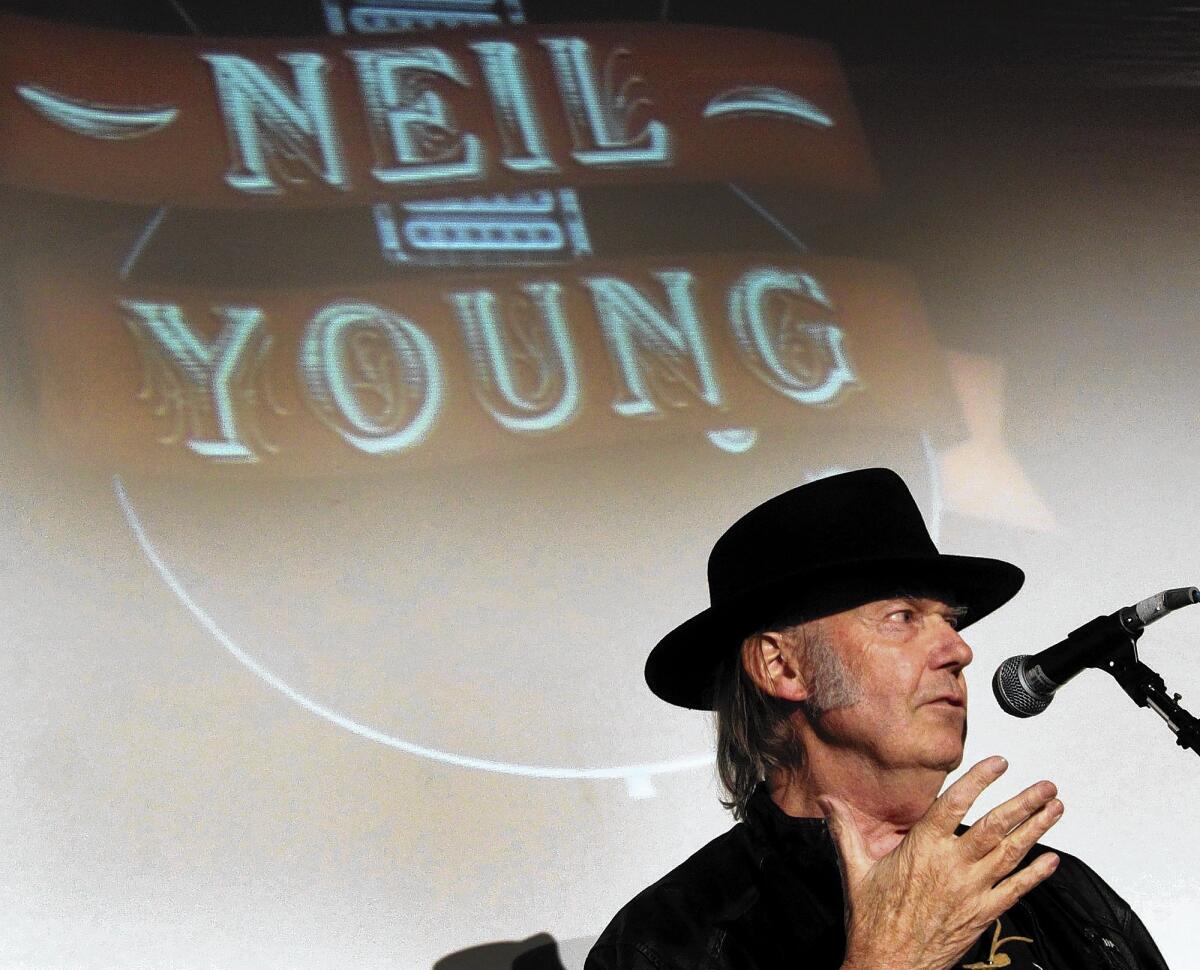Neil Young goes on the record at Grammy event

- Share via
The annual bash thrown by the Grammy Producers & Engineers Wing at Village Recorders studio in West Los Angeles is typically one of the livelier Grammy week events, but this year, as if to ensure there would be not a whiff of stuffiness, they chose Neil Young as the recipient of this year’s President’s Merit Award.
Tuesday’s gathering was dominated by producers and other recording studio personnel but also drew industry executives and musicians, including longtime friend and collaborator Stephen Stills, Kris Kristofferson and Jakob Dylan, among others. Additionally, Dave Matthews made a surprise appearance and sang three songs in tribute to Young, who did not perform.
Where most awards show acceptance speeches — those on television anyway — are quick-hit thank yous to a laundry list of names, Young used the occasion to talk at length about how and why he records, and how that process is integral to the fiercely individualistic music he’s been making for nearly 50 years.
TIMELINE: Grammy winners through the years
“This is a cool night, because we’re all here together,” Young, 68, told the audience packed into the Village’s biggest room on Tuesday. “I’m kind of a producer, partially an engineer [but] I’m not really good at either one, as anyone who’s heard my records can attest.
“I’m in a world where technical things don’t matter that much,” he said. “But that’s only one way of making records. There’s a lot of you of out here who just craft some beautiful records and take great care with every note.
“I know I’m not one of them,” he added with a smile.
Young, however, has historically gone to great lengths to make sure his records sound the way he wants them to, and often has caused record company executives considerable headaches with eleventh-hour fixes or changes to his music.
“I like to capture the moment,” he said. “There’s a lot of compromises you make to get that feeling. But in the long run, that’s where the pictures are when I hear my words. That’s what we try to record.”
He recalled using the Village studios in 1974 working on a track that would become one of the cornerstones of his extensive repertoire, “Like a Hurricane,” and gave the audience a play by play of how the song came together.
PHOTOS: Iconic rock guitars and their owners
Young explained that he recorded the instrumental track first on his home recording studio with his band, Crazy Horse, the day after he’d written it. At that time, he was under doctors orders not to sing because of recent surgery. “But that didn’t stop the music,” he said.
He decided to record the vocal later and took the tape to play back at the Village. “I was here at this place in 1974 or something. This is back when I couldn’t sing.”
Pausing, he added, “By the way, I know I can’t sing,” causing an eruption of laughter. “But at that time I couldn’t make a sound.”
Eventually he added the vocal, urging the studio engineer to record everything from the moment he set foot in the studio, something that has long been standard practice for Young, though many engineers often wait to press “Record” until they set and adjust recording levels and prepare various pieces of equipment.
Young recalled instructing him, “Record all the time. That’s why we’re here. It’s a studio — record! Come on. Practice at home! The red button’s not that scary, it’s really not.”
More laughter followed, after which Young made his point.
“It was the first time I was ever listening to ‘Like a Hurricane’ and it was here in this building,” he said. “There’s a message in there somewhere. My memory of this place is what it is: It’s that you do records like that. The idea is for me is to try to get magic. Who knows where the hell it comes from? I don’t. So please record.”
PHOTOS: Unexpected musical collaborations
He also put in a word for his Pono music system, which he aims to formally announce in March at the South By Southwest Music Conference in Austin. It’s a playback system that will access audiophile-quality digital source material from all four major label groups and allow consumers to decide what resolution level they want to pay for. Currently, CDs contain about 20% of the digital information that’s contained in master recordings, and mp3 files offer only 2% to 3% of what the artist originally heard in the studio.
“The thing we do is we create great stuff in the studio, and then we kiss [it] goodbye,” he said. “It didn’t used to be that way. That’s something that happened to us, that’s an injury we sustained and it’s deeply hurt us.
“So the time has come for us to recover, and to bring music back to the people in a way that they can recognize it in their soul, through the window of their soul, so they can feel, and vibrate and so that they can get goosebumps,” Young said.
“We cherish those goosebumps. Never lose those.”
Twitter: @RandyLewis2
More to Read
The biggest entertainment stories
Get our big stories about Hollywood, film, television, music, arts, culture and more right in your inbox as soon as they publish.
You may occasionally receive promotional content from the Los Angeles Times.










